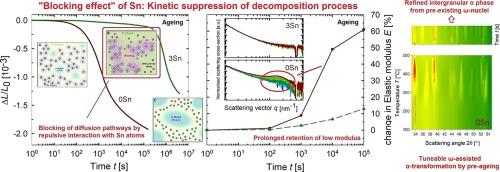β-钛合金弹性模量工程:用Sn调节沉淀动力学
IF 7.9
2区 材料科学
Q1 MATERIALS SCIENCE, MULTIDISCIPLINARY
引用次数: 0
摘要
β-Ti合金的设计策略要么旨在抑制扩散辅助等温ω- iso析出,要么旨在通过ω辅助途径控制这些析出物向α相的转变,而ω- iso形成的动力学在这两种情况下都起着至关重要的作用。因此,控制ωiso的形成是设计具有目标性能的β-Ti合金的关键。我们提出,通过控制添加到β-Ti合金中的Sn含量,可以获得广泛的微结构,从而实现模量工程。在加入Sn后,我们观察到ωiso的形成呈指数级放缓,这是基于阻断β-稳定剂原子的扩散途径,而不受热力学抑制的转变。这种对ωiso形成的抑制使β-Ti合金能够保持生物医学应用所需的较低弹性模量。此外,添加Sn降低了ω- iso相的数量密度,也阻碍了ω-辅助α-的形成,而无Sn在低温预时效后形成细小的针状晶内α板和形貌相似的α gb侧板。这些结果为之前提出的Sn诱导的动力学减速提供了坚实的证据,并表明可以根据应用需要通过调整Sn的ωiso沉淀动力学来定制机械性能。本文章由计算机程序翻译,如有差异,请以英文原文为准。

Elastic modulus engineering in β-titanium alloys: Tuning the precipitation kinetics using Sn
Design strategies for β-Ti alloys either aim at the suppression of the diffusion-assisted, isothermal precipitation or at the controlled transformation of these precipitates into α phase by an ω-assisted route, with the kinetics of formation playing an essential role in both cases. Therefore, controlling the formation is pivotal in the design of β-Ti alloys with targeted properties. We propose that by controlling the Sn content added to β-Ti alloys a wide range of achievable microstructures for modulus engineering is accessible. Upon Sn addition, we observe an exponentially slowed down formation based on blocking of diffusion pathways for the β-stabiliser atoms without the transformation being thermodynamically inhibited. This suppression of formation allows the β-Ti alloys to maintain a lower elastic modulus necessary for biomedical applications. Furthermore, as byproduct, reducing the number density of precipitates upon Sn addition also impedes the ω-assisted α-formation, while the Sn-free forms fine, acicular intragranular α plates and side-plates with similar morphology after low temperature pre-ageing. These results provide solid evidence for the previously proposed Sn-induced kinetic deceleration and suggest that the mechanical properties can be tailored as required by the application by tuning the precipitation kinetics using Sn.
求助全文
通过发布文献求助,成功后即可免费获取论文全文。
去求助
来源期刊

Materials & Design
Engineering-Mechanical Engineering
CiteScore
14.30
自引率
7.10%
发文量
1028
审稿时长
85 days
期刊介绍:
Materials and Design is a multi-disciplinary journal that publishes original research reports, review articles, and express communications. The journal focuses on studying the structure and properties of inorganic and organic materials, advancements in synthesis, processing, characterization, and testing, the design of materials and engineering systems, and their applications in technology. It aims to bring together various aspects of materials science, engineering, physics, and chemistry.
The journal explores themes ranging from materials to design and aims to reveal the connections between natural and artificial materials, as well as experiment and modeling. Manuscripts submitted to Materials and Design should contain elements of discovery and surprise, as they often contribute new insights into the architecture and function of matter.
 求助内容:
求助内容: 应助结果提醒方式:
应助结果提醒方式:


